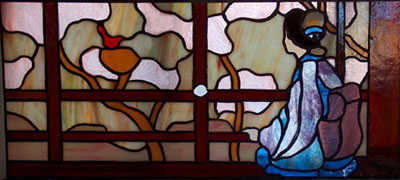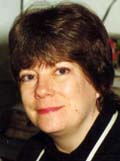Design of the Month · September 2006
-

"Madame Butterfly"
This design is one of 70 from the collection In Nature's Realm.
Background
Madame Butterfly is one of a set of 48 panels depicting the world's greatest operas. This is an ongoing scholarship fund-raising project for the College of Music at the University of North Texas. To date I have completed thirteen of the panels.
In 2002 a young gentleman walked into my studio, asking if I did any hot glass work. He was the facilities manager for the UNT Murchison Performing Arts Center and needed a replacement wall sconce. While I could not help him with the sconce, he was impressed with the stained glass work and promised to come back some day. "Right," I thought. "How many times have I heard that?"
Well, he was good to his word. In 2003 he returned with a new fund-raising idea involving replacing some boring metal light fixtures in the Opera Theatre with small stained glass panels depicting the world's greatest operas. The university was interested enough in his concept to commission me to do a mock-up panel and present my quote for the entire project. I created the Carmen panel, a list of 70 operas from which the donors could choose, and a proposal for payments and donations. My proposal was accepted, and now the Sponsor-an-Opera stained glass panel project is well under way.
Madame Butterfly was the fifth panel commissioned.
The design
Each opera design must meet specific and non-changeable restrictions in order to be installed into existing lighting hardware inside the theatre. Panel size must be exactly 11" wide by 8" high, and framed in 1/8" U channel zinc. Each panel is mounted onto the lighting hardware through a 1" circular hole exactly in the middle of the panel. A single washer and decorative screw hold the panel in place. Consequently, each design must take into account the fact that it will be oriented horizontally, and must be balanced so that two major design elements are on either side of the center hole. Another major restriction is that I may only use opaque glass, since two bright fluorescent lights are mounted on either side of the center hole, and are only ½" away from the panel.
From a design perspective, each panel must be instantly recognizable as that opera and none other. When I received word that the patron had selected Madame Butterfly, I went online and searched for photographs and posters of that opera. Madame Butterfly is a bit easier than most operas, since it has iconographic settings not normally associated with European-based operas. Madame Butterfly is set in Japan and features colorful kimono costumes and cherry blossom sets. I found an old opera poster showing the heroine in contemplation at the pivotal moment of the opera: her American lover has left her and she is contemplating suicide. I chose this setting for the stained glass panel. I downloaded the image onto my computer and started to work.
I used Adobe Photoshop to crop the vertical image into a square. I then loaded it into Glass Eye 2000 as a background image. I traced over the image of the heroine, Butterfly, saving this crucial design element as a group. Next I drew the rectangle and center hole design at exact dimensions, and saved that as a group. I moved Butterfly into place on the right side of the center hole, then sized the group to fit within the rectangle's size restriction. That's why she's kneeling. There is no room to have her standing up and still be recognizable within a panel only 8" high. I then added a hand rail and background cherry trees in blossom.
I needed something on the left side to balance the panel. I added a solitary bird in its nest, giving Butterfly something to look at as she gazes out her lonely window. I added break lines where necessary and selected glass colors to give a high contrast between the kimono and the soft pink background of the cherry trees, making sure that I selected only opaque glass. The only exception to this is the flesh tone. I prefer to use cathedral bronze glass and acid etch the back surface to opaque it. I believe this gives a more true-to-life flesh tone than opaque flesh-toned glass.
I have removed the center hole from the downloadable pattern, since that feature was necessary only for installing these panels at the Lyric Theatre. I have also added greater realism to the bird.
Construction
When working with small, very intricate panels such as all the opera panels, I use the copper foil method. I printed out two full-sized copies of the design, and used one as a reference layout and the other was cut apart and glued onto the glass. I like this method of using patterns, since all the glass is opaque (usually very dense) and it is critical that the pieces are cut and ground to exact outlines.
I first cut out all pieces, ground them, and foiled everything. The pieces were laid out on top of the pattern and soldered. I flipped the panel over, soldered the back, and then added the 1/8" U channel zinc frame. After soldering, I cleaned it thoroughly and added black patina. After washing that, I waxed and polished it.

Madame Butterfly installed at the UNT Murchison Performing Arts CenterRevising the pattern
This pattern may be modified to fit other dimensions. To change it to a square or vertical orientation, group the heroine figure on the right, group the songbird and nest on the left, then remove as much cherry tree lines in the middle as you want. This design is readily adaptable.
About the artist

Christie A. Wood has been working glass since 1993, when she took her first beginning copper foil class at a local stained glass retail store. What started out as a hobby soon became an obsession, and then a profession. After working out a business plan, Art Glass Ensembles was launched in 1995 as a part-time studio. In 1996 it became a full-time studio, servicing the needs of the retail giftware market. In 1998 Art Glass Ensembles purchased the "Something Special" line of stained glass cabinet inserts, and became a full-service stained glass manufacturing studio. Christie and her husband relocated from Pennsylvania back to their home state of Texas in 2001, when Art Glass Ensembles continues to grow and flourish. She now has three CDs of patterns in Glass Eye 2000 format available: Opus One, The Glass Menagerie, and In Nature's Realm. Christie would be happy to answer questions sent to her email address.
This pattern may be used to make one or more artworks for sale or personal enjoyment. This pattern may be printed for personal use only and may not be sold or given away in printed or electronic form.
Each month we feature a project designed using Glass Eye 2000. Do you have a project to share with the world? Contact Dragonfly Software and your creation might be our next Design of the Month.